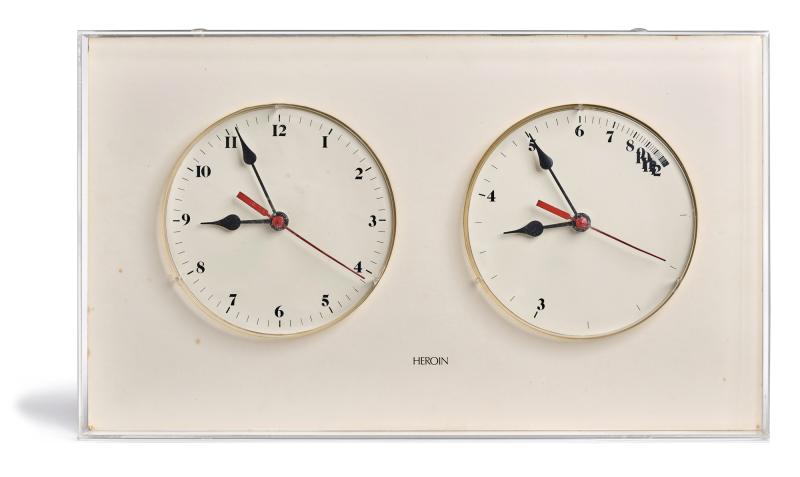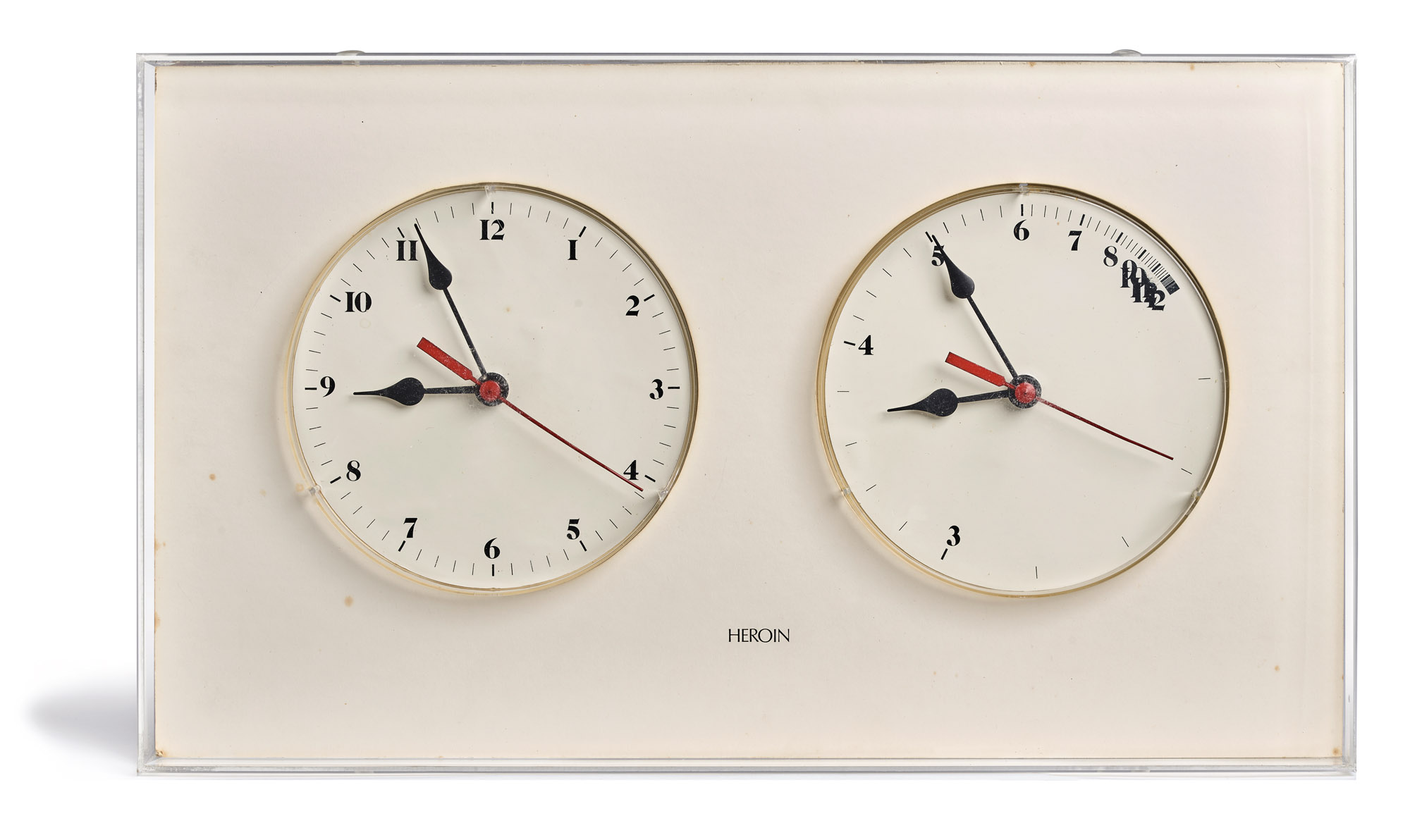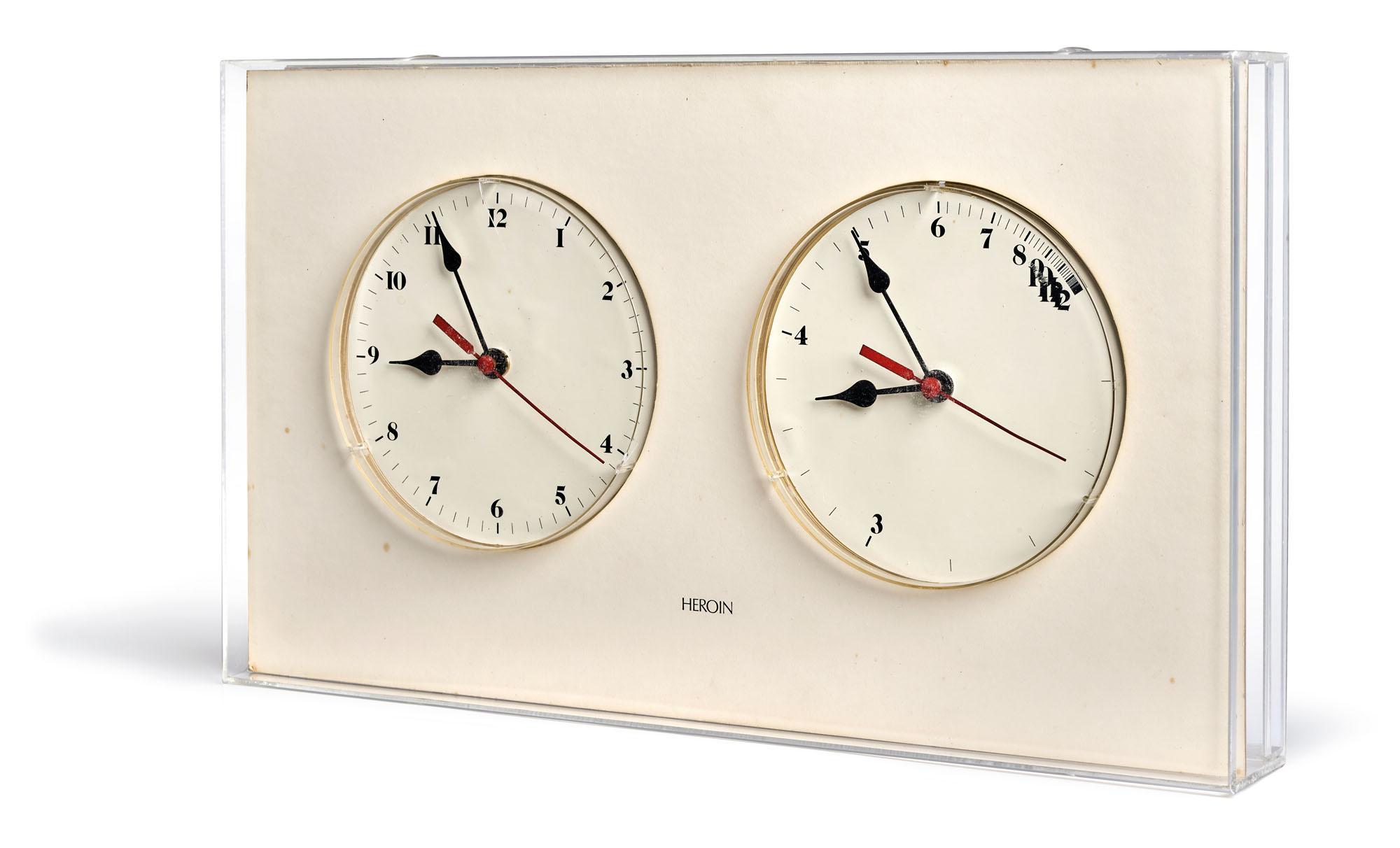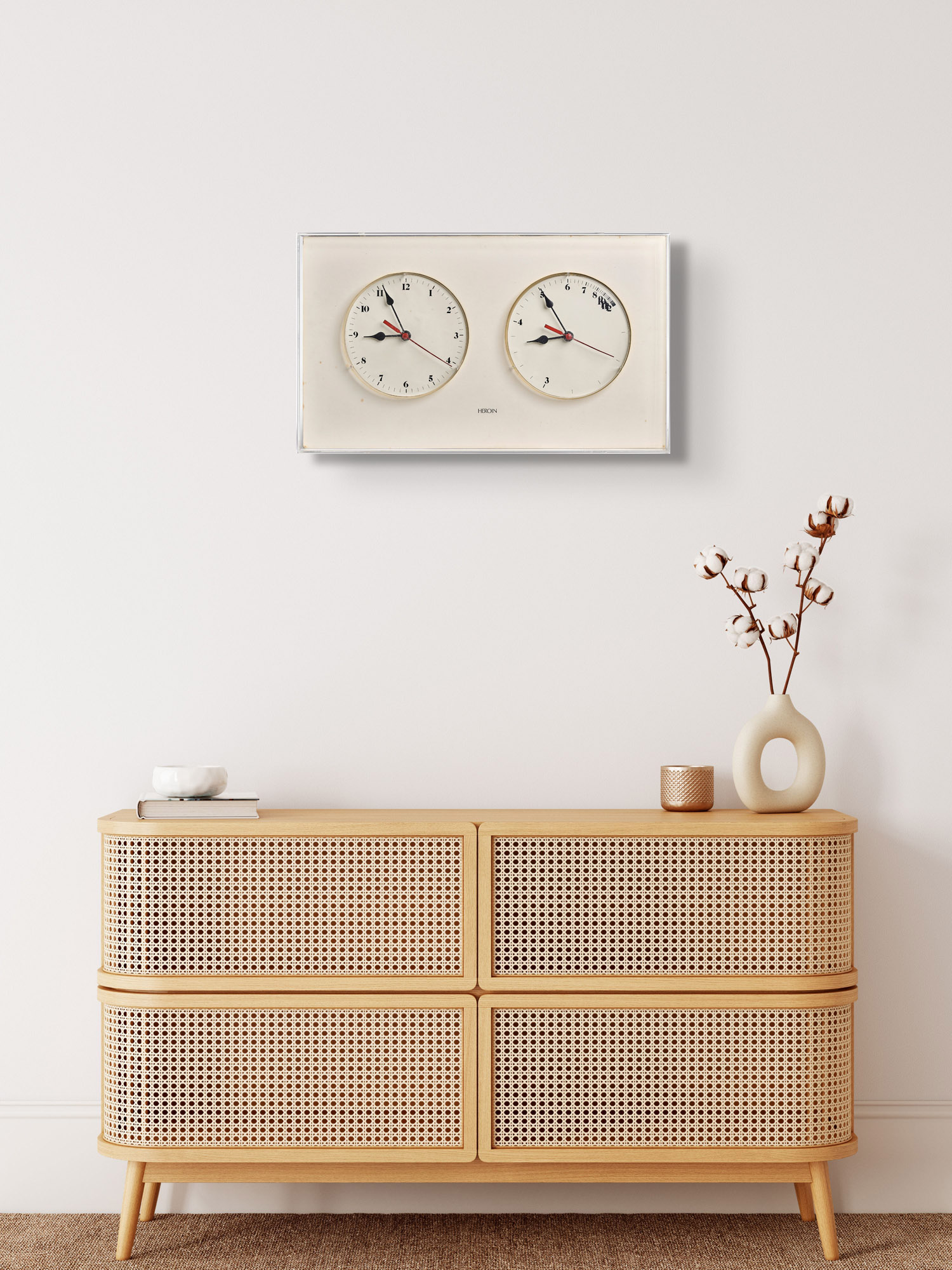BRETT WHITELEY (1939-1992)
The Heroin Clock 2 1981
Estimate: $50000 - 70000
Sold For:
$82500 hammer
$101250 inc. buyer's premium
Description
BRETT WHITELEY (1939-1992)
The Heroin Clock 2 1981
two clocks mounted in a Perspex box
27.5 x 46.5 x 6.5 cm
signed dated and inscribed verso: especially reproduced for Clive Evatt, 'The Heroin Clock 2' 1981 brett whiteley/ 24/october 1981/ (19th CENTURY HANDS)/ about the authorship of idea of this art object.../ it would aesthetically be wrong to add even a studio signature stamp to the front. even initials./ it should be checked that the red second hands are in exact sinc [sic] all the time or the picture is false./ 'The Heroin Clock 2' is not a moral statement, a discription [sic] of destruction a glimpse of evil or any of that sort of thing./ it is more like a scientific matter of fact - a visual equasion [sic], a comparasion [sic] if you like, of addiction to non-addition [sic]. (But it should be noted that this object should produce a feeling of anxiety.)
stamped verso with artist's monogram
Provenance:
Acquired from the artist, Clive Evatt QC, Sydney, 1981
Mrs Elizabeth Margaret Evatt, Sydney
Reference:
Sutherland, K., Brett Whiteley: Catalogue Raisonné, Schwartz Publishing, Melbourne, 2020, vol.7, pp.899-900, referenced in note for cat.84s
Related Works:
The Heroin Clock 1981, two clocks mounted in a Perspex box, 28.0 x 46.0 cm, The Whiteley Estate, Sydney (stock no.BWS1830)
Estimate: $50000 - 70000
Result Hammer: $82500
Whiteley’s alcohol and drug-fuelled regime during the early 1980s in no way diminished his creative output. He continued to produce significant works across painting, drawing and sculpture. In 1981 alone, he had five solo exhibitions; Brett Whiteley: Drawings and Gouaches at Philip Bacon Galleries, Brisbane, Brett Whiteley: Recent Nudes at the artist’s studio in Sydney, and three exhibitions highlighting his prints and graphics at Australian Galleries, Melbourne, Greenhill Galleries, Perth, and Kalamunda Gallery of Man, Western Australia. While not only signifying Whiteley’s remarkable capacity to produce, the five exhibitions in 1981 collectively showcase his expansive thinking and unquenchable desire to create. His ability to turn his hand with success to a variety of mediums further demonstrates the astonishing diversity of his influences and interests.
Whiteley came of age when illicit drugs were becoming more prevalent and their use moved in tandem with fame. Whiteley had been partial to alcohol throughout his career only graduating to ‘more serious mind-altering chemicals’ in the mid-1970s.1 Wendy Whitely notes, ‘it seemed at the time that the heroin consumption was just another experiment with another thing.’2 Whiteley was very open and autobiographical about his addiction, choosing to incorporate aspects of it within his work as casually as he did birds or palm trees. Famously, Henri’s Armchair 1974-75 (also once in the collection of Elizabeth and Clive Evatt QC) had been commissioned by the Art Gallery of New South Wales. The foreground shows burnt matches and heroin paraphernalia strewn on the table, so the work was not accepted by the gallery, and Whiteley was asked to paint over the offending objects; of course, he did not.3 His 1978 Archibald Prize winning self-portrait Art, Life and the Other Thing highlights the torture of his addiction, complete with a syringe adhered to the canvas. This was a candid confession of his involvement with substances and places the matter of his drug dependence at the centre of his practice and career as whole. Ruth Faerber notes, ‘this is a daring, soul searching statement, profoundly revealing, philosophically questioning. It transcends mere originality by the sheer force of honesty.’ 4
The Heroin Clock 2 1981 arguably is Whiteley’s most overt representation of his addiction. Two clock faces sit side by side on a clean white surface encased in a simple Perspex box with ‘heroin’ printed plainly in the lower centre. The left clockface is conventional, yet the right shows numbers 3 to 8 spaced sporadically with numbers 9 to 12 compressed on top while the rest of the clockface is left void. The work indicates that Whiteley’s heroin use was merely an extension of his practice, a fixture as necessary as time itself. Perhaps the object is not commenting on the compression of time when using heroin, which is the conventional reading, but suggests the act of using created space and stillness in the fever pitched pace Whiteley worked. Wendy Whiteley comments retrospectively, ‘life was intense for him, he set himself very high goals and loathed the feeling of failure…for a time [the heroin] allowed him to be still and relaxed.’5 The verso inscriptions offer a glimpse into the usually inaccessible interior landscape of Whiteley’s mind.
'The Heroin Clock 2' is not a moral statement, a discription [sic] of destruction a glimpse of evil or any of that sort of thing./ it is more like a scientific matter of fact - a visual equasion [sic], a comparasion [sic] if you like, of addiction to non-addition [sic]. (But it should be noted that this object should produce a feeling of anxiety.)6
Another example of this work sits on the wall in Brett Whiteley’s studio nestled discreetly amongst an assemblage of images. The Heroin Clock 1981 was never publicly exhibited, and the present work was created at the request of Clive Evatt QC, remaining in his family’s personal collection until now. This is a deeply personal work, and it is a rarity to see an object so intensely intertwined with Whiteley come to market.
Footnotes
1. White, S., and Judd. C., ‘Art, Life and the Other Drugs’, Meanjin, Winter 2002, accessed February 2024, https://meanjin.com.au/essays/art-life-and-the-other-drugs/#easy-footnote-bottom-2-26119
2. Ibid.
3. Morris, L., ‘Brett Whiteley Painting Smashed Australian Art Auction Record’, Sydney Morning Herald, 26 November 2020, accessed February 2024, https://www.smh.com.au/culture/art-and-design/brett-whiteley-painting-smashes-australian-art-auction-record-20201126-p56i74.html
4. Faerber, R., ‘Grand Finale’, The Australian Jewish Times, 4 January 1979, p.12, accessed February 2024, https://trove.nla.gov.au/newspaper/article/263237225?searchTerm=Archibald%20prize%201978
5. Wendy Whiteley interviewed for ‘Art, Life and the Other Thing Podcast’, Art Gallery of New South Wales, 18 September 2021, accessed February 2024, https://www.artgallery.nsw.gov.au/art/watch-listen-read/art-life-and-the-other-thing-podcast/
6. Brett Whiteley, Heroin Clock 2 1981, two clocks mounted in a Perspex box, 27.5 x 46.5 x 6.5 cm
Clementine Retallack
Specialists
-

Cameron Menzies, Chairman & Head of Private Sales
cmenzies@menziesartbrands.com
+61 (0) 466 636 142 -

Asta Cameron, Art Specialist
acameron@menziesartbrands.com
+61 (0) 400 914 088 -

Clementine Retallack, Front of House Manager & Associate Art Specialist
cretallack@menziesartbrands.com
+61 (0) 478 493 026
Location
Sale & Exhibition Details
-
Auction
27 March 2024
6:30PM AEDT
1 Darling Street
SOUTH YARRA VIC 3141
artauctions@menziesartbrands.com -
Exhibition
-
Sydney
14-17 March 2024
10:00AM to 5:00PM AEDT
12 Todman Avenue
KENSINGTON NSW 2033
art@menziesartbrands.com -
Melbourne
21-26 March 2024
10:00AM to 5:00PM AEDT
1 Darling Street
SOUTH YARRA VIC 3141
artauctions@menziesartbrands.com
-



